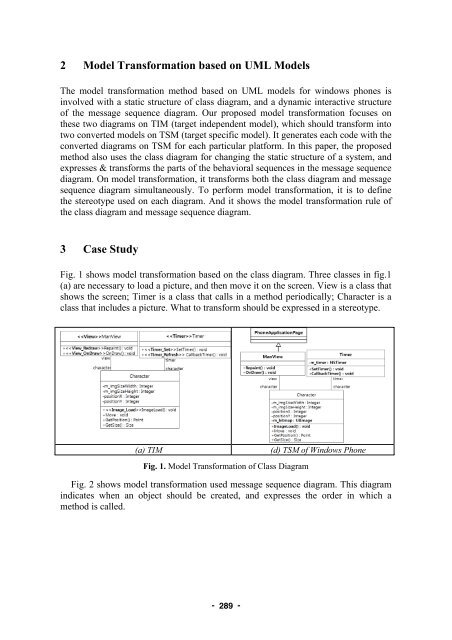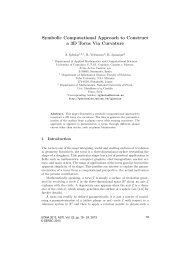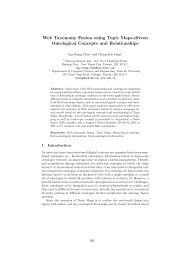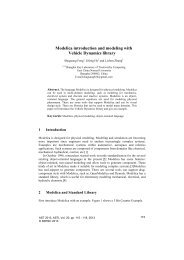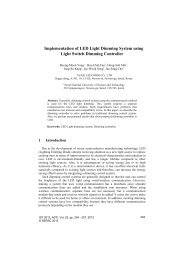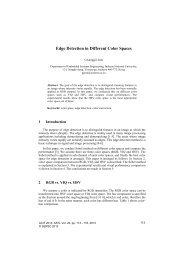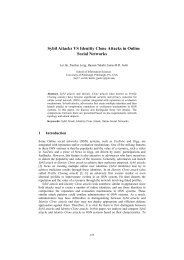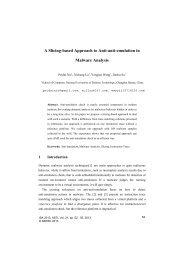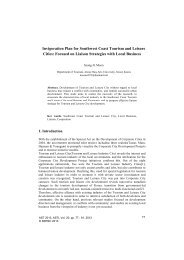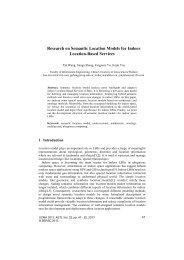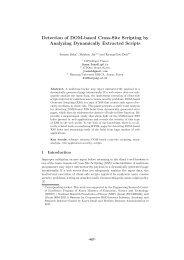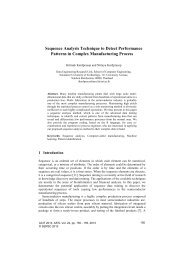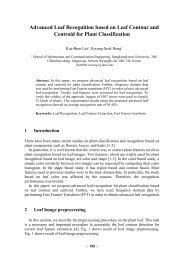Concretization of UML Models based on Model Transformation for ...
Concretization of UML Models based on Model Transformation for ...
Concretization of UML Models based on Model Transformation for ...
You also want an ePaper? Increase the reach of your titles
YUMPU automatically turns print PDFs into web optimized ePapers that Google loves.
2 <strong>Model</strong> Trans<strong>for</strong>mati<strong>on</strong> <str<strong>on</strong>g>based</str<strong>on</strong>g> <strong>on</strong> <str<strong>on</strong>g>UML</str<strong>on</strong>g> <str<strong>on</strong>g><strong>Model</strong>s</str<strong>on</strong>g><br />
The model trans<strong>for</strong>mati<strong>on</strong> method <str<strong>on</strong>g>based</str<strong>on</strong>g> <strong>on</strong> <str<strong>on</strong>g>UML</str<strong>on</strong>g> models <strong>for</strong> windows ph<strong>on</strong>es is<br />
involved with a static structure <str<strong>on</strong>g>of</str<strong>on</strong>g> class diagram, and a dynamic interactive structure<br />
<str<strong>on</strong>g>of</str<strong>on</strong>g> the message sequence diagram. Our proposed model trans<strong>for</strong>mati<strong>on</strong> focuses <strong>on</strong><br />
these two diagrams <strong>on</strong> TIM (target independent model), which should trans<strong>for</strong>m into<br />
two c<strong>on</strong>verted models <strong>on</strong> TSM (target specific model). It generates each code with the<br />
c<strong>on</strong>verted diagrams <strong>on</strong> TSM <strong>for</strong> each particular plat<strong>for</strong>m. In this paper, the proposed<br />
method also uses the class diagram <strong>for</strong> changing the static structure <str<strong>on</strong>g>of</str<strong>on</strong>g> a system, and<br />
expresses & trans<strong>for</strong>ms the parts <str<strong>on</strong>g>of</str<strong>on</strong>g> the behavioral sequences in the message sequence<br />
diagram. On model trans<strong>for</strong>mati<strong>on</strong>, it trans<strong>for</strong>ms both the class diagram and message<br />
sequence diagram simultaneously. To per<strong>for</strong>m model trans<strong>for</strong>mati<strong>on</strong>, it is to define<br />
the stereotype used <strong>on</strong> each diagram. And it shows the model trans<strong>for</strong>mati<strong>on</strong> rule <str<strong>on</strong>g>of</str<strong>on</strong>g><br />
the class diagram and message sequence diagram.<br />
3 Case Study<br />
Fig. 1 shows model trans<strong>for</strong>mati<strong>on</strong> <str<strong>on</strong>g>based</str<strong>on</strong>g> <strong>on</strong> the class diagram. Three classes in fig.1<br />
(a) are necessary to load a picture, and then move it <strong>on</strong> the screen. View is a class that<br />
shows the screen; Timer is a class that calls in a method periodically; Character is a<br />
class that includes a picture. What to trans<strong>for</strong>m should be expressed in a stereotype.<br />
(a) TIM (d) TSM <str<strong>on</strong>g>of</str<strong>on</strong>g> Windows Ph<strong>on</strong>e<br />
Fig. 1. <strong>Model</strong> Trans<strong>for</strong>mati<strong>on</strong> <str<strong>on</strong>g>of</str<strong>on</strong>g> Class Diagram<br />
Fig. 2 shows model trans<strong>for</strong>mati<strong>on</strong> used message sequence diagram. This diagram<br />
indicates when an object should be created, and expresses the order in which a<br />
method is called.<br />
- 289 -


